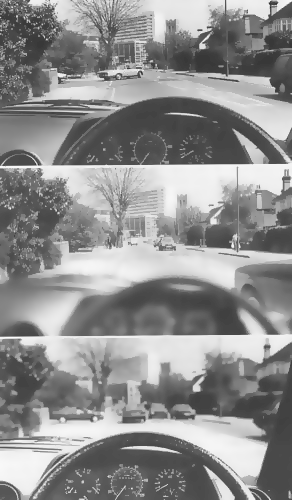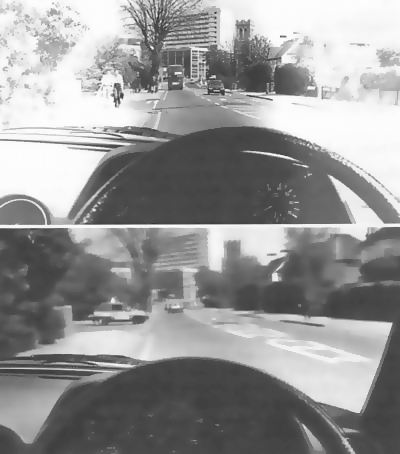Observation
The Video Course teaches you everything about modern cars.
To be an advanced driver you need to become a skilled observer. Good powers of observation, which demand practice and thought, can keep you out of trouble in 90 per cent of all potentially dangerous incidents. You need to absorb all the information you see around and ahead of you when you drive, and select what is useful. All drivers do this to a certain extent, but the real value of skilled observation does not come until it has been developed into an art. Just as a ship's master reads his chart in difficult waters, you must read the road ahead so that you can anticipate potential dangers.
Your eyesight

Making sure that your vision is satisfactory is the first step you must take. Not only do an alarming number of drivers have eyesight shortcomings, but many of them are also totally unaware that anything is wrong. Eyesight usually deteriorates so gradually that a person who 20 years ago read a number-plate without difficulty when passing his test may now be suffering from a potentially dangerous defect in his vision, and possibly compensating for it subconsciously. Many people who try to avoid driving at night, because they are not happy about their vision in the darkness, ought to acknowledge that their daylight vision might also be less than perfect.
Reading a number- plate for the requirements of the Government test is not demanding enough. The standard is to be able to read a number-plate with the old 31/2in letters at a distance of 75 feet (22.86 metres), or a plate with the newer 31/sin letters at a distance of 67 feet (20.42 metres). It is possible to pass this requirement with little or no sharp sight in one eye, yet such a serious defect prevents good judgement of distance. Tunnel vision, the tendency to concentrate only on the view directly ahead and remain oblivious to anything more than a few degrees to the side, also does not stop you reading a number-plate at 25 yards, yet it seriously restricts the powers of observation which every driver must have.
Good peripheral sight is essential in order to see what is happening at each side of the car. Long sight and short sight are extremely common (and proportionately worse at night), but too many drivers remain unaware of it until eventually they are forced to have an eye-test. Colour blindness also causes serious problems, particularly if it takes the form of an inability to distinguish red; as well as brake lights and traffic lights, red is used for all danger signs on the road. If you have not been to an optician for two years, it would be wise to go for a proper check whether or not you already wear spectacles. There will probably be nothing wrong; but if there is, it is better to find out now rather than after a possible serious accident caused by your defective sight.

If you need glasses for driving, wear them always. It is a good idea, too, to keep a pair of dark glasses in the car all the year round, for the glare from the setting sun in winter can be just as hard on the eyes as the brightness of a sunny day in summer. Economy is pointless, as it is with anything to do with road safety. Polarised glasses are the best, but try them in your car first to make sure that they do not excessively emphasise the stress patterns which can be seen in car windscreens when this type of glass is used. If you normally wear spectacles, the ideal is a second pair with tinted glass lenses. Sunglasses with cheap plastic lenses can scratch easily and make parts of your vision `foggy', and they tend to impair your perception in shade.
Sunglasses are useful in reducing eyestrain, but never be tempted to wear them at night if you are bothered by dazzle. Glare from oncoming headlights is reduced, but so is your perception of everything else which is marginally lit. Failing to see a pedestrian, an unlit cyclist or even just the kerb could have fatal results. If your eyesight is good and oncoming headlights do dazzle you, you are probably making the elementary mistake of looking right at them. With a little willpower, you can train yourself to look away from the headlights and towards the nearside of the road instead.
This ability comes naturally with plenty of night driving experience, and in time you will appreciate the headlights of passing traffic for that little bit of extra light they throw into your path. The inevitable reaction to headlights coming towards you is to concentrate your attention on the part of the road directly in front of your car illuminated by your own headlights. At all other times, however, you must look further ahead, day or night.
Where to look
Many inexperienced drivers spend most of their time behind the wheel looking at the part of the road immediately in front of them, thereby failing to notice sufficiently early the approach of junctions, roundabouts, parked cars and any other potential hazards. You should concentrate your gaze on a point some way ahead, while at the same time taking in events even further in the distance, closer to you and on either side.
This selective vision requires concentration and has to be developed with practice, so it is a good idea to train yourself to cast your eye over as wide a field of vision as possible. An advanced driver with excellent peripheral vision can often point out objects at the side of the road (such as a dog on the verge) that even his passengers have missed, while at the same time keeping the centre of his gaze focused on the road ahead. This centre of focus must be adjusted constantly according to speed and how far ahead the road is visible.
You must also be observant about what is going on behind you. The interior mirror must be used frequently, and always before you change course or speed, but you should not rely on this alone. Properly adjusted door or wing mirrors give you a broader field of vision behind, although there will always be some blind spots, notably just above your right shoulder and perhaps at the three-quarter rear position one each side (especially on a car with large metal panels at these points). If your car is inadequately equipped, advice about choosing mirrors to minimise these blind spots is contained in Safety at the Wheel .
You must always allow for blind spots when checking the view in your mirrors. The advanced driver uses his mirrors so often that he should always be aware of the vehicles behind him, and should know when one is momentarily in a blind spot. Even so, the only way to ensure that you are never caught out by a car or motorcycle hidden in a blind spot and about to overtake is to cast a quick — and we really mean quick — glance over your right shoulder if all looks safe ahead. This is especially good practice when changing lanes on a motorway or dual carriageway, joining traffic flow from a slip road or changing lanes in a one-way system, as well as when pulling away from the side of the road. You need to be particularly vigilant about what might be lurking in a blind spot when you are travelling on a busy motorway; if a lane of traffic to your right is flowing only slightly faster than your lane, a car can be concealed in a blind spot for some time. Motorway accidents are often caused by a driver changing lanes without properly checking in his mirrors and over his shoulder whether it is safe to do so, and then moving broadside into another car.
You must be absolutely certain that no vehicles, people or animals are behind you when you need to reverse. If your car gives poor vision to the rear, get out first and walk around to have a look. To reverse blindly, hoping that nothing or no-one — a playing child, for example — is in the way, is unforgivable.
Selective observation
Being observant is essential to advanced driving, but the refinement of this skill comes in learning to be selective in your observation. When driving in a busy city centre, for example, you need to be able to distinguish what should be acted upon and what can be ignored. These are some pointers to give you an idea of the range of visual information which helps you to become a safer driver:
You can glean plenty of information by observing other vehicles. A parked car with its reversing lights on is clearly about to move backwards. A puff from the exhaust of a parked car means that its driver has just started the engine and may pull out into your path. A puff from the exhaust of a lorry climbing a hill tells you that its driver has changed down and will be travelling even more slowly; if you are coming down a hill and see a slow-moving lorry climbing towards you, it could conceal a car whose driver is about to attempt a rash overtaking manoeuvre. A decrepit car or van might have poor brakes. Give more room to the aggressive or sloppy driver; drop further back from a driver ahead trying to overtake when there is no opportunity, or a driver who is paying more attention to finding a particular address in town than he is to the road. If you are behind a bus , a passenger putting his hand up to the bell will give you advance warning that the bus is about to stop.
Anyone who has passed a driving test should have all road signs committed to memory, but it is still worth referring to the Highway Code periodically to check that you know all the warning signs (triangular), advisory ones (rectangular) and mandatory ones (circular). British roads are quite well provided with signs, all of which are erected by local authorities for a purpose; you should know at a glance what any sign is telling you.
No matter how experienced a driver you are, there is always room to improve your observation skills still further. Take pride in developing your own methods. At a familiar junction in town with a restricted view, for example, you might notice that reflections in a shop window act as mirrors and show you what otherwise invisible traffic is approaching. With this sort of keen observation, the advanced driver can always make his motoring that little bit safer.
Summary
The Ultimate Car Mechanics video course
Learn everything about modern cars from our new video series.
Learn more >-
We build a Mazda MX5 Miata from scratch
We start by tearing down and then rebuilding the whole car.
-
Every part explained
There's ridiculous detail on every part. Clearly and easily explained.
-
All modeled in 3D
We've created the most detailed 3D model ever produced so we can show you everything working.






